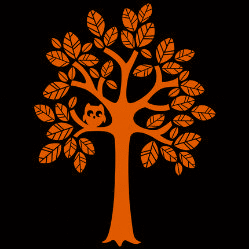
For the uninitiated, the Dennison Manufacturing Company is just about synonymous with Halloween. Right at the start of the 1900s, Dennison was on board with the burgeoning popularity of the October holiday. It manufactured Halloween greeting cards and decorations that were used at Halloween parties that were held with increasing frequency across the United States. Then in 1909, to help promote sales and teach customers how to display their decorations and maximize their spooky fun, Dennison published its first Bogie Book ("bogie" was a name for mischevious Halloween spirits).
The Bogie Book was a hit from the start, and (excepting for a gap of three years, when it resurfaced in 1912) was pubished annually from then on, with a few interruptions, right through the mid-1930s. After that date, the title and size changed (it was renamed, variously, "The Party Book," "Parties," "Hallowe'en Suggestions," "The Halloween Book," and "Hallowe'en Parties"), but mostly everything else stayed the same.
What's wonderful about the Bogie Books is they provide a historic record that not only helps to date antique and vintage Halloween ephemera, but they illustrate how these decorations were to be used. And if one scopes the photographic record for Halloween party images (which are rather scarce if you're scoping near the beginning of the 20th century), one can clearly see that celebrants eagerly adopted Dennison's suggestions. Many photos are exact or near-exact representations of the display suggestions Dennison offered for table settings, nut cups, chandelier and ceiling festooning, and costumes (which were not infrequently made out of crepe paper).
These slim volumes now serve as guides for collectors of antique and vintage Halloween decorations, but they have also become highly sought-after collector's items themselves. A 1920s edition in good conditon can run between $100-$200, and copies from the teens (or the extremely rare 1909 edition) can blow a hole in your wallet the size of cannonfire. If owning an original is not of interest, but the images and information are, some folks have reproduced them. They pop up on various Web sites and on eBay, from time to time.
What's interesting when one looks at the costume offerings from the first quarter of the 20th century is that the bulk seem to be festive or, at most, have only the most distant shadows of spookiness. There's an absolute dearth of gore and terror, or even eerieness. Many of the costume suggestions for females mimic the hemlines and silhouettes of the era, so around 1915 a female party-goer inherits the lampshade skirt and in the 1920s female costumes get more long, lean and columnar. Looking at the costume illustrations in the Bogie Books one is amazed that many of these orange-and-black confections were composed of crepe paper.
Most early costumes seem to be more like fashion dresses adapted for Halloween. A spider at the hip, in place of a rhinestone ornament. A bat at the bustline, instead of a foliate design. Jack o' Lanterns at the hemline, instead of some beaded pattern. Some costumes were a bit more allegorical, with the party-goer adorned with appropriate details. For example, a "spider girl" might have her skirt decorated with a web pattern and a "cat girl" might have hers swagged with the arching curves of spooked black cats. There were some "person" costumes, here and there. The witch was a perennial favorite, as was the Perriot.
From a vintage clothing perspective, Bogie Books are also valuable. Most early Halloween costume examples have not survived, because paper costumes were not likely to make it to another season, and throughout the decades, most people have thrown surviving examples in the trash. Lastly, of the examples that do survive, many are in delicate condition, because crepe paper is so friable. So for those who have an interest in early Halloween costumes, these Dennison Bogie Books provide wonderful, plentiful examples.
The Dennison Company (born in Framingham, Massachussetts) still survives today, as does its American rival, Beistle. Thanks to them, vintage clothing collectors have a terrific view into spooky times past. ^_^





3 comments:
Great article! I'd love to see these collected into book form! Imagine what a great coffee table book this stuff would make, as the vintage Halloween images are such a powerful example of pure Americana!
I LOVE these too...and I want one but they are impossible to find. But I agree with Gilly about what a fab coffee table book that would make. I'd be the first in line to buy it too!
I wonder if our friend the Dustwitch has one of these Bogie books in his clutches...hmmm.
^_^
Post a Comment